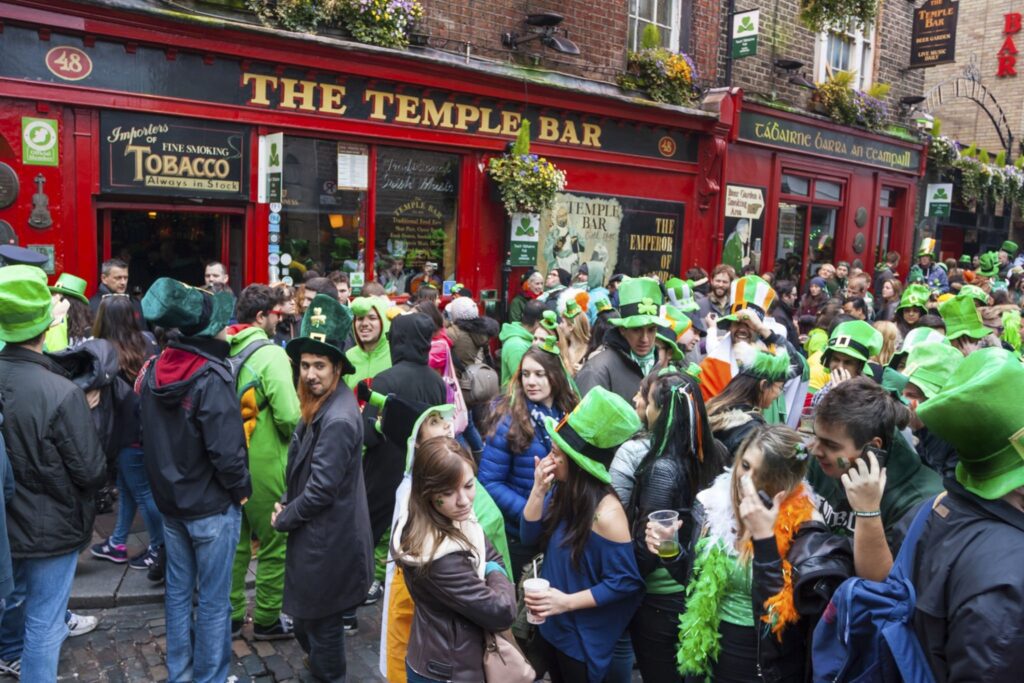Introduction
Every year on March 17, Ireland bursts into a sea of green as locals and visitors alike celebrate Saint Patrick’s Day. This iconic holiday blends religious roots, centuries-old traditions, and vibrant modern festivities. Whether you’re drawn by the legendary Dublin parade or curious about village customs, Saint Patrick’s Day in Ireland is a cultural immersion not to be missed.

The History and Meaning Behind Saint Patrick’s Day
Saint Patrick’s Day began as a religious feast honoring Saint Patrick, the missionary credited with bringing Christianity to Ireland in the 5th century. Over time, the day evolved into a celebration of Irish identity. Traditionally, March 17 included attending church and sharing meals with family. Today, it’s a full-fledged national holiday marked by public festivals, parades, music, and dancing.
Traditions Across Ireland
Rural vs. Urban Celebrations
In Ireland’s cities, the holiday is lively and colorful. Dublin, Cork, Galway, and Belfast host multi-day festivals featuring live performances, themed installations, and public dancing. Meanwhile, rural villages preserve a more intimate approach—beginning with church services, followed by local parades and community gatherings in pubs and town halls.
Religious and Cultural Practices
Most Irish people still pin fresh shamrock to their coats, attend Mass, and join in community events. „Drowning the shamrock“—dropping the herb into a drink and toasting—is a cherished tradition.
Dublin’s Famous Parade
One of the most renowned celebrations is the Dublin St Patrick’s Day Parade. It features:
- Elaborate floats and giant puppets
- Marching bands from Ireland and abroad
- Themed performances and vibrant costumes
- A sea of spectators in green

When to Book Your Trip
Planning to experience Saint Patrick’s Day in Ireland? Book your flights and accommodation 6–9 months in advance. March is peak travel season, and prices for hotels and airfare rise steeply. Last-minute availability is rare, especially in Dublin.
What to Expect from the Weather
March weather in Ireland is unpredictable—expect a mix of rain, wind, and occasional sun. Temperatures usually range from 4°C to 11°C (39°F to 52°F). Pack layers, warm clothing, and a waterproof jacket to stay comfortable throughout the day.
Getting Around on Parade Day
On March 17, expect road closures in city centers, especially in Dublin. Public transportation will operate on adjusted routes and schedules and will be extremely crowded. Walking is often the best way to navigate the city and get to parade viewing points.
Budgeting for St. Patrick’s Day
Be prepared: accommodation and flight costs are at their annual peak. Budget accordingly for higher prices on hotels, tours, and even pub meals during the week of the festival.
Food, Drink, and What to Wear
Contrary to popular belief, corned beef and cabbage is more of an Irish-American tradition. In Ireland, bacon and cabbage or hearty Irish stews are typical. You might also find colcannon (mashed potatoes with kale or cabbage), soda bread, and Irish lamb dishes. At pubs, Guinness flows alongside live traditional music.
As for attire, wearing green is a must. From leprechaun hats to shamrock face paint, dressing up adds to the festive spirit.
🎟 Book here → Traditional Irish Pubs & Music Crawl in Dublin

Fun Facts and Stats
- St. Patrick wasn’t Irish—he was born in Roman Britain.
- The Dublin parade attracts over 500,000 spectators.
- Roughly 13 million pints of Guinness are consumed globally on March 17.
- The world’s shortest parade (23 meters) took place in Dripsey, County Cork.
A Personal Story
During my first St. Patrick’s Day in Galway, I wandered into a neighborhood pub after the parade. Locals welcomed me like family. A fiddler struck up a tune, and soon the whole pub was singing. I didn’t know all the words—but I felt completely at home. That moment defined what makes the day so special.
Hidden Gems to Explore
- Dingle’s 6 AM parade—Ireland’s earliest!
- Hook Lighthouse in Wexford—celebrations by the sea
- Downpatrick in Northern Ireland—home to St. Patrick’s grave
- Local céilís (community dances) in small towns
🎟 Book here → Dublin Mythology & Folklore Walking Tour
Saint Patrick’s Day is more than just a party—it’s a powerful display of Irish pride, hospitality, and joy. From solemn traditions to unbridled festivities, there’s something for every traveler.
So pack something green, book your flights, and prepare to say „Sláinte!“ in the heart of the Emerald Isle.
Ready to experience it?
FAQs
Is St. Patrick’s Day celebrated in Ireland?
Yes! It’s a public holiday, with parades and parties across the country.
What are some Irish traditions on St. Patrick’s Day?
Attending Mass, wearing shamrock, community parades, and pub gatherings.
What should I wear?
Green! Add shamrock pins, scarves, or novelty accessories.
Is the Dublin parade worth it?
Absolutely. It’s one of the largest in the world, with incredible performances.
Are there family-friendly options?
Yes—many towns have kids’ activities, and Dublin offers relaxed viewing zones.




